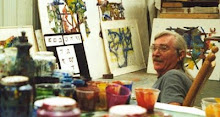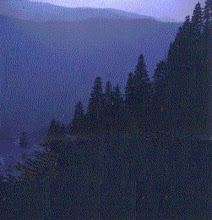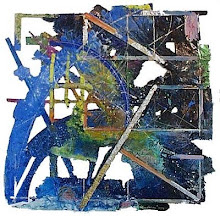One reads the morning sky in the manner of deciphering its pattern of form and movement so to chart the possibilities for one's own outer and inner day. The wind out of the east, low clouds and the feel of moisture in the air means the likelihood of rain, and that means no work possible in the vegetable garden if it's summer, no cutting firewood if it's winter, and so that opens up the possibility of inner immersion in work in the studio or up in the study.
Or, wandering through the woods I notice the track of a deer, and begin to read its story - how big a deer, male or female (if the back feet make tracks outside of the line of the front it's more likely to be a female I think), was it going fast or slow, was it heading single-mindedly toward some goal, or was it wandering (and therefore probably lazily grazing its way along - what's been nipped along its path?), how old (this morning? - the crumbled, heaved up edges moist and not dried out, or yesterday or last week - the edges dry and cracked - but has it been raining for several days keeping the track fresh for many days?).
Or, at the grocery store I am intently searching for something I've run out of, and happen into an old friend not seen for months. Our eyes meet and I read their face - the flicker of an eyelid, the cant of the head, the movement of the eyes - whether they meet me directly, or shift away in discomfort; the corners of the mouth either beginning to stretch into a smile or set in defense of something, reading the signs of well being, or not, of welcome, or not, of embarrassment, or the reaction traced there to my asking "how have you been?"
Or, I am standing on the front porch with the morning's first cup of tea in hand, waiting to address the new sun coming up over the trees to splash across the field below the house with radiant greens, and waiting too for how that makes me feel - comforted, confirmed, even positive about what I might accomplish this day.
Or, I'm in the studio, stirring paint, and stirring my perception, trying to read the nascent shape forming there into actuality - a smudge into the turning edge that catches the light just so,
Readings. And then there are the books. They are readings not much different than the ones above, in either breadth, depth, variety, or method. I am not a careless reader, but I do so in much the same way that I read other "sign" - the morning sky, an animal's track, some one's face, or a painting.
I've read much in my 64 years, a little of it valuable and a lot of it forgettable. Over the last 17 years it has narrowed mostly to reading over and over again the ones I know to be valuable because it has become increasingly hard to find new books that actually refresh and nourish - that encourage me to experience life in new and nourishing ways. The list of the ones I reread is short but rich -
Lewis Hyde's
The Gift which I return to to be reminded of the true commerce of art
McLean's
A River Runs Through ItHarry Middleton's
On the Spine of Time ( both the carefully lucid parts and those when he slips into mere glibness - I've come to love his feet of clay as I would a friend's and don't much judge him for it)
John Haines'
The Stars, The Snow, The FireNelson's
The Island WithinPaulsen's
Clabbered Dirt, Sweet GrassBarry Lopez's
Arctic DreamsJohn Inglis Hall's
Fishing a Highland StreamSuzuki's
Zen Mind, Beginner's MindT.S. Eliot's
Four Quartets (its elagaic quality every bit as forlorn as Samuel Barber's "Adagio"
Robert Bly's translations of Rilke's poems
Gary Snyder's
A Place in SpaceChristopher Camuto's
Another CountryI have read all of these many times. I once came to the end of Camuto's
Another Country and without hesitation simply turned to the first page and began again. It was like a really good painting in the way it continually nourished and revealed itself to me. Some of its enduring significance lies in its layering of stories - his personal narrative telling upon tales from the past that in turn tell upon stories of language, myth and culture, and that in turn upon a listening to what the land can tell us. On a few days, when my life seems exhausted of content, purpose, direction, or possibility, I turn to it for solace, and bathing myself in the rhythms of his thoughts and words, I find life turn brighter, and for me (I'm a painter after all) incandescent. And of course to say that its significance lies in its layering is to admit that what I look for in reading signs in the morning sky, a deer's track, a face in the crowd, or in a book, is the intricate layering of life itself that is true.







